Best cash flow management software tools at a glance
Before we dive into the details, here’s a sneak peek of the best cash flow management software on the market today:
- Cube: A spreadsheet-native platform that integrates with Excel and Google Sheets, offering real-time cash flow tracking and automation for streamlined workflows
- Vena Solutions: Combines spreadsheet functionality with cash flow forecasting and reporting tools
- Anaplan: A financial planning platform that models, forecasts, and analyzes cash flow scenarios
- Workday Adaptive Planning: Provides cash flow planning with data and scenario modeling
- Planful: Offers end-to-end financial planning and cash flow analysis with integrations for data unification
- Centage: Tailored for smaller businesses, Centage simplifies cash flow management with visual dashboards and reports
- Abacum: A cash flow tool designed for collaborative financial planning, forecasting, and tracking liquidity
- Causal: Features cash flow forecasting and scenario analysis to support financial planning
- Tesorio: Focuses on cash flow automation, offering features for accounts receivable, payables, and working capital management
- Prophix: Delivers cash flow planning and analysis tools that help businesses identify trends and manage liquidity across operations
- HighRadius: Specializes in accounts receivable automation, providing insights into cash flow and working capital optimization
- Jirav: Combines cash flow planning with budgeting and forecasting to help businesses understand the impact of financial decisions
- SAP Cash Management: A solution for enterprises, SAP Cash Management centralizes cash visibility and liquidity planning
- Kolleno: An accounts receivable and cash management platform that supports cash collection and liquidity tracking
- PlanGuru: Designed for small businesses, PlanGuru includes tools for cash flow forecasting, budgeting, and scenario analysis
- Float: Focuses on cash flow forecasting for small businesses, integrating with accounting software to provide cash visibility and projections
- Agicap: Centralizes accounts payable and receivable, connects with banks and ERP systems, and gives finance teams real-time visibility into cash positions for faster, more reliable decisions
What is cash flow management?
Cash flow management involves tracking and controlling how much cash enters and leaves your business's accounts. Good management helps businesses maintain healthy amounts of working capital and liquidity and sets the foundation for growth and expansion.
Here are some of the typical tasks involved in cash flow management:
- Calculating expenses (cash outflows) and ensuring there is enough incoming cash (cash inflow) to cover them
- Reducing excess cash on hand
- Building cash reserves and rainy day funds
- Double-checking spending and tracking receipts
- Verifying that you're using cash in the best possible way
Financial planning and analysis teams need to monitor, analyze, and optimize their company's cash to make accurate forecasts about the future.
Why is cash management important?
Cash management ensures that a business always has the necessary cash to pay its expenses.
Expenses might include:
- Payroll
- Debt repayments and interest on loans
- Bank fees and interest
- Rent and utilities
- Insurance expenses
- PP&E (property, plant, and equipment)
When a business cannot pay its expenses, it goes insolvent, which can lead to a hit to its credit rating, legal actions by creditors, and even liquidation. Good cash management makes companies more secure by minimizing avoidable errors that lead to insolvency.
What is cash flow management software?
Cash flow management software is designed specifically to help businesses plan, monitor, and manage the movement of money in and out of the business. This software is crucial for ensuring that a company has enough liquidity to meet its operational needs and avoid financial distress.
These solutions can automatically connect income statement and balance sheet information from your accounting software and organize it into cash flow statements and reports, making it easy to uncover real-time insights into the nuances of your cash flow.
Cash flow software
Cash flow software gives businesses tools to monitor, analyze, and optimize their cash inflows and outflows. These platforms often integrate seamlessly with accounting and financial management tools and send data back and forth.
Cash flow software keeps you ahead of potential liquidity issues, forecasts cash needs, and makes your operations sustainable. Features typically include:
- Automated data consolidation
- Customizable dashboards
- Scenario planning
- Alerts for cash shortages or surpluses
- Integrations with spreadsheets and other financial systems
Cash management software
Cash management software helps businesses control and allocate their funds. These platforms support day-to-day liquidity needs and help you put excess cash to optimal use.
Cash management software integrates with various financial tools to streamline your treasury operations. Features typically include:
- Payment scheduling and fund transfers
- Fraud detection and compliance tracking
- Tools for automating repetitive tasks
- Real-time tracking of cash balances
- Insights for strategic allocation of surplus funds
Cash forecasting software
Cash forecasting software predicts future cash positions by analyzing historical data, current trends, and business projections. These platforms play a key role in long-term financial planning and help businesses anticipate risks or opportunities.
Like the other two variants, cash forecasting software integrates real-time data for accuracy and consistency. Features usually include:
- Multi-scenario planning and trend analysis
- Predictive analytics for liquidity management
- Integration with accounting systems for data consolidation
- Detailed forecasting reports and visualizations
- Alerts for potential future cash shortages or surpluses

Benefits of cash flow management software
Not sure how software can improve your cash flow management? Here are some of the best benefits of using cash management tools:
1. Better visibility into your ending cash balance
Cash flow tools make it easy to see the impact of net income on your cash flow statement.
For example, you buy a new piece of equipment and want to see how its depreciation affects your ending cash balance. Based on the logic you've built into the software, you can expect the status of current and future assets to populate directly on your cash flow statement. With a better view of your ending cash balance, you can immediately assess the financial health of your business.
All of these steps are possible through manual work, but cash flow management software reduces the risk of errors and accelerates the processes so you can monitor your balance and be more agile in reacting to it.
2. Access to real-time data
Accurate, up-to-date cash flow data is at the core of informed financial decisions. Cash flow software integrates with your accounting platform and bank accounts, so every sale, expense, and transfer is fed into one central database. These immediate updates give you a real-time snapshot of your current financial position at any time, even outside of office hours.
Previous cash flow systems would rely on periodic data transfers, rather than immediate updates. Therefore, when speaking to shareholders or superiors, finance teams would need to qualify their figures with projected estimations, leading to confusion and a lack of clarity.
With the best cash flow tools, you can now give an accurate, convincing report of how much cash is flowing into and out of your business at any time.
3. More profitable business decisions
Detailed insights into financial data fuel more profitable business decisions from inventory management to risk mitigation. It’s not just about knowing how much cash is available at a given moment. Automated financial platforms analyze income and expenditure patterns to pinpoint areas that improve profitability.
For instance, they can identify the most profitable products or services so businesses can adjust their sales strategies to capitalize on high-margin items.
Cash flow software that integrates with inventory management alerts you to purchase when prices are low and prevents you from overstocking. This dynamic approach to inventory management maximizes your return on investment when compared to less communicative purchasing strategies.
Forecasting features empower businesses to evaluate the financial implications of different decisions. With these insights, you can better mitigate risks and avoid choices that lead to cash shortages or unnecessary stress.
Sure, most finance teams are more than capable of adopting these decisions by themselves. However, cash flow tech sees everything everywhere all at once, getting to the same conclusion with far less investment in time and resources.
4. Efficient use of time and money
For every software innovation like integration, automation, and artificial intelligence, the direction of traffic is the same—increased productivity in a shorter time frame and on a lower budget.
Cash flow management software combines all of these breakthroughs to save hours of manual work and runaway project budgets. They simplify routine but time-consuming tasks like data entry, transaction reconciliation, and report generation, allowing teams to focus on more strategic thinking that adds value to the business.
Automated data flow between apps not only saves time and effort in the short term but also reduces the likelihood of costly errors. And while it’s impossible to completely eliminate mistakes, smart accounting tools significantly impact the extent and frequency of crises.

How to choose the best cash flow management software
As we’ve seen, there is no one-size-fits-all cash flow software. It all depends on your company’s size, level of expertise, and organizational needs. So to help you find the tool that will best improve your financial planning and analysis, we’ve created a checklist of factors to guide you in making a decision.
Ease of use
A user-friendly interface tops the list, enhancing adoption and productivity by reducing the learning curve. Essentially, a well-designed tool simplifies your daily operations, rather than adding complications. Usability includes devices too; if you’re often on the go, the ability to access and manage cash flow from your phone is crucial.
Look out for cash flow management software with a clear, intuitive layout with easy navigation. SAP may cover all possible bases, but all those features and customizations are overkill for companies that only need a minor streamlining of their current processes.
Integration capabilities
Seamless integration with existing systems is equally crucial, preventing data silos and ensuring a unified financial ecosystem. Constantly switching between programs can be extremely frustrating when the pressure is on, so ensure your systems sync together easily.
Unless you’re going for an all-in-one platform, check that your cash flow integrates with existing accounting, ERP, and banking software. Real-time data sharing between apps gives you a single source of truth, enhancing reliability and decision-making.
Accuracy
Forecasting capabilities are paramount in financial planning and analysis, and the more accurate your forecasts, the more confidence you have in creating strategies and roadmaps. Integrations will reduce the risk of human error by automatically entering data, but that’s not the end of the story.
Error-checking algorithms can flag anomalies, adding another level of accuracy to your reports and forecasts. Many cash flow management solutions also include audit trails that record all data changes so you can easily verify and correct potential mistakes.
Real-time analytics and reporting
The software's ability to provide real-time data access is a game-changer, allowing for agile cash management strategies. When you’re safe in the knowledge that you’ve got accurate information to hand, you can be more decisive, rather than putting off decisions until you can verify your data.
Tools with up-to-date data are ubiquitous now, so you shouldn’t have much trouble finding an application that meets your needs. Where it gets interesting is how they leverage immediate data transfer. Will your real-time updates identify trends, forecast future cash flows, and alert managers to potential cash shortfalls before they become problematic?
Customization and scalability
Customization options are key to tailoring the software to unique business needs. More than tailoring your tool to your way of working, flexible platforms allow you to seamlessly scale as your business expands.
Features like customizable dashboards, adjustable reporting capabilities, and the ability to handle increased transaction volumes all help you avoid frequent upgrades or replacements. Check customer testimonials to see if the company’s claims align with reality.
Cost-effectiveness
Lastly, cost-effectiveness is a fundamental consideration, encompassing licensing fees, implementation costs, and additional expenses. By meticulously evaluating these aspects, businesses can make an informed choice, aligning their cash flow software with both current requirements and future financial success.
Many modern FP&A tools pitch their product through a return on investment calculator. While these are unlikely to be 100% accurate, they at least help you think beyond up-front costs and subscriptions.

The best cash flow management software tools
New tools are stealing the limelight by communicating better with other apps and allowing finance teams to be more agile. Integrations, automations, and customizations empower finance teams to save time, improve accuracy, and operate in a way that works for them.
Of course, not all tools are the same. To demystify the market, we’re going to look at the top cash flow management platforms, with their key features, benefits, pricing, and more details.
1. Cube

Cube is a spreadsheet-native FP&A platform that helps companies hit their numbers without having to sacrifice their spreadsheets. Cube helps retail finance departments work anywhere—integrating natively with both Excel and Google Sheets—so that they can plan, analyze, and collaborate with the ultimate speed and confidence.
Cube enables users to create and manage your direct and indirect cash flow. Users can automatically compile data from various sources, such as sales, expenses, investments, and financing activities, to generate cash flow statements and get valuable insights into a company's financials and quality of earnings.
Cube also provides agentic AI and no-code capabilities. The platform’s intelligent agents help FP&A teams transform and eliminate the friction of their traditional workflows. Small businesses can access features such as smart variance analysis and smart forecasting to uncover insights, understand performance, and drive action without spending hours in spreadsheets.
This platform is the only software that automatically transfers data from any spreadsheet into a multi-dimensional database. By connecting all of your essential data sources to Cube, its intelligent mapping transforms your data into a single source of truth that you can analyze, share, and derive insights from.
Key features
- Automated data consolidation for a unified view of financial performance across all systems
- Shareable planning templates that teams can customize and reuse to streamline planning cycles
- Bi-directional Excel and Google Sheets integration so your team can forecast and report in familiar tools
- Drill-throughs and audit trails that show the full history of data changes and source-level detail
- Conversational AI apps for Slack and Teams that provide instant answers to finance questions in plain English
- Custom reports and dashboards to share insights into your cash flow patterns, cash runway, budgeting, expenses, and more.
- Project future cash flows based on different scenarios to anticipate cash shortages or surpluses and make informed decisions to manage liquidity
Integrations
To perform advanced cash flow management in familiar environments, Cube seamlessly connects tools like:
- Spreadsheets: Microsoft Excel, Google Sheets
- Accounting and finance tools: Oracle NetSuite, Intuit QuickBooks, Sage Intacct, Xero, PeopleSoft
- HR and ATS tools: ADP, Greenhouse, SAP SuccessFactors, Workday
- Billing and operations: ChargeBee, Zuora
- Sales and marketing workflows: Hubspot, Salesforce
- Business intelligence capabilities: Power BI, MongoDB, Tableau, Microsoft Azure SQL
Don't see what you're looking for? View all Cube integrations.
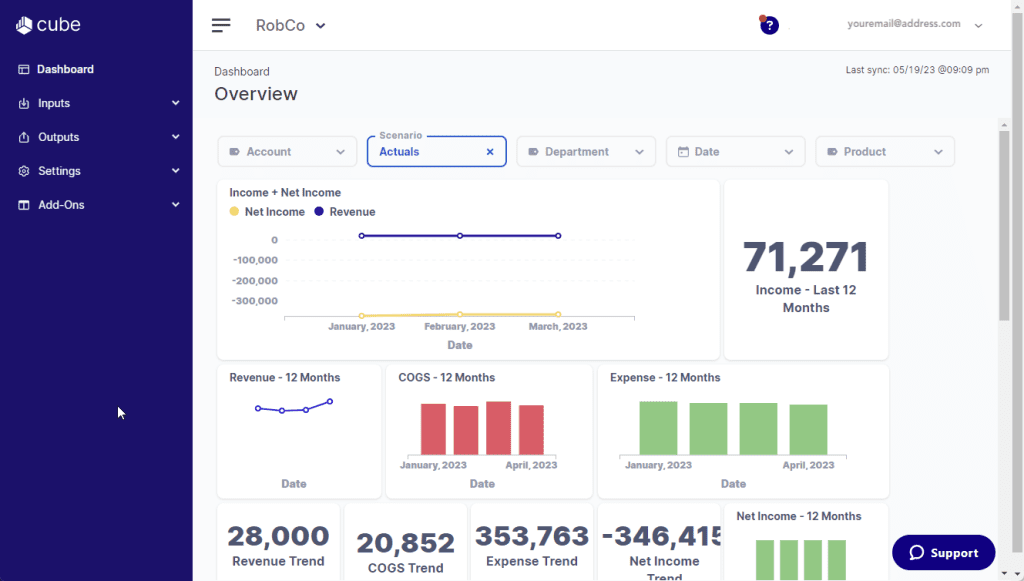
Pros
- Provides immediate visibility into cash positions so teams can react quickly and avoid liquidity surprises.
- Saves hours of manual work by automatically consolidating financial data across sources.
- Builds confidence in reporting with accurate, audit-ready cash flow statements.
- Helps leaders make smarter investment and spending decisions with reliable forecasting.
- Shortens planning cycles by keeping everyone aligned on the same real-time numbers.
- Reduces risk of errors and compliance issues through built-in controls and clear data governance.
Cons
- Doesn't provide multilingual support as of this article's publishing date
Customer review ratings: Capterra: 4.6/5
Pricing: Cube starts at $30,000 annually, with custom plans to fit the specific needs of your organization.
See detailed pricing.

2. Vena Solutions

Vena Solutions is a cloud-based financial planning and cash management system that enables financial teams to handle all of their financial data better. This software has many solutions and tools to help facilitate better financial planning, cash flow management, financial reporting, and more.
Key features
- Driver-based modeling to better predict financial outcomes
- AI capabilities to enhance forecasting accuracy with deeper insights
- Workflows that take you through your modeling process step by step
- Central security database with encryption that supports access controls
Integrations
Vena Solutions has a robust array of integrations, pairing with Excel, Dynamics 365 Business Central, and SQL Server and facilitating seamless data handling within the Microsoft ecosystem. It connects with popular accounting and finance platforms such as Oracle, Sage Intacct, SAP, NetSuite, Salesforce, and Intuit QuickBooks. Vena also supports integrations with collaboration tools like OneDrive, SharePoint, and Dropbox, as well as data visualization through Power BI.

Pros
- Provides knowledgeable guidance through a responsive support staff
- Offers flexible reporting options that simplify data analysis
- Enables mobile access so users can work from anywhere
Cons
- Presents a steep learning curve for many users
- Slows down when running large or complex reports in the cloud
- Depends on consultants to build and maintain models
- Limits functionality for Mac users compared to PC users
- Excludes integration with Google Sheets
Customer review ratings: Gartner: 4.5/5
Pricing
Vena doesn’t provide any set monthly pricing information. They offer a 7-day preview and will give you a demo of their software to help you decide if you contact them.
Cube embraces your existing models. You can customize your cash reporting in Cube with an ease that's impossible within Vena. Modifying your templates or models is easier with Cube. We'll never charge you for support, whereas Vena makes money on their fee-based consultative business structure.
Scenario modeling is more intuitive in Cube because we integrate with Excel and Google without heavy coding language baked into our templates.
3. Anaplan

Anaplan is a cloud-native cash management app that helps orchestrate better business performance.
It’s designed to help businesses of all sizes solve financial-related challenges. Using the suite of tools in the Anaplan platform, users can streamline financial processes and better understand everything from day-to-day cash flow to complex financial solutions.

Key features
- Scenario modeling that analyzes various pathways to understand potential impacts
- Sales and purchase forecasting to align resources accordingly
- Employee cost predictions so you can plan for future employee-related expenses
- Currency-specific risk management to handle fluctuations in currency value
Integrations
Anaplan enhances its capabilities through integrations with Google Sheets and Microsoft 365, Microsoft Excel, and Microsoft PowerPoint, facilitating robust data manipulation and presentation. Anaplan’s integration with Salesforce supports seamless CRM data management, while integrations with Boomi, Informatica, MuleSoft, and SnapLogic enhance data integration across various systems. For advanced analytics, Anaplan integrates with Power BI and Tableau. Additionally, Cloudworks, DocuSign, and Workiva Chains integrations expand their functionality for document management and workflow automation.
Pros
- Links to any number of planning streams through one dashboard
- Offers an intuitive UX with a good deal of customizability
- Enables analysis down to a granular level
- Pulls detailed real-time reports in just a few clicks
Cons
- Demands a steep learning curve for smaller businesses
- Limits Excel integration to an add in that runs on specific machines
- Offers limited report layouts and formatting options
- Forces users to abandon and rebuild existing models
Customer review ratings: Capterra: 4.3/5
Pricing
Anaplan has four different pricing plans, although they do not have any set pricing plans. You’ll need to talk with a member of their team to work out a custom plan that meets your needs.
Cube’s approach is particularly beneficial for organizations looking to enhance their existing spreadsheet-based processes without significant changes. On the other hand, Anaplan requires a total overhaul and a steeper learning curve.
Similarly, Anaplan doesn’t integrate as smoothly with Excel as Cube, often requiring users to adapt to its native modeling environment. This departure from traditional spreadsheet tools makes it noticeably less user-friendly than Cube.
4. Workday Adaptive Planning
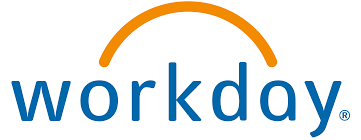
Adaptive Planning by Workday is an enterprise-level budgeting and financial planning software.
This software facilitates financial planning and collaboration across an entire organization without needing spreadsheets and other manual processes.
You can easily create budgets and forecasts, run scenarios, and track expenses and sales. You can also create custom cash flow schedules and sheets.

Key features
- Comprehensive tools for creating and managing budgets and forecasts
- Workforce planning to reduce uncertainty around employee expenses
- Sales goal planning that aligns with financial plans and forecasts
- Capital planning to track an additional strand of cash flow impacts
- Scenario modeling to evaluate and compare various pathways
- Performance management to assess your achievements against financial goals
Integrations
Workday Adaptive Planning shares standard integrations with Microsoft Excel, and major ERP systems like Oracle, NetSuite, SAP, and Sage Intacct. The platform supports Salesforce for CRM data synchronization and integrates with Microsoft Dynamics (Great Plains), Deltek Vision, Epicor, Plex, and Multiview, providing support across various business functions.
Pros
- Delivers robust cash flow features without relying on spreadsheets
- Provides detailed audit trails that support compliance
- Generates strong financial insights through reporting features
- Visualizes future cash flows with scenario planning and forecasting tools
Cons
- Differs from Excel logic, which increases training requirements
- Lacks compatibility with Google Sheets and limits Excel use
- Extends onboarding timelines significantly
- Prevents users from retaining or enhancing existing models
Customer review ratings: G2: 4.3/5
Pricing
Workday Adaptive Planning does not make any pricing plans public. They offer free trials and demos of their software and will work out a custom quote if you reach out to their team.
Cube vs Workday
The main difference between Cube and Workday Adaptive Planning is the scale of their target audience. Cube is aimed at environments where Excel and Google Sheets models are already up and running, seamlessly integrating and enhancing them without major workflow upheaval.
Workday requires a great deal of adaptation to its ecosystem, while Cube is much easier to integrate with familiar tools.
5. Planful

Planful is a cloud-based financial planning and analysis platform that is a robust solution for cash flow analysis and continuous planning.
The platform is split into structured planning, dynamic planning, consolidation, and reporting.
These elements take you through all the FP&A stages you need to get visibility into your financials and make informed decisions.

Key features
- Planful Predict uses artificial intelligence and machine learning for pattern recognition
- Driver-based cash flow forecasting to tweak specific areas of your business
- Financial close management to maintain accuracy and promptness in payment
- Workforce planning to stay on top of your payroll, recruitment costs, and more
- Scenario analysis to compare a range of strategies
- Financial consolidation across multiple entities for more detailed reporting
Integrations
Like most other tools, Planful integrates with Microsoft Excel, Salesforce, Google Sheets, Oracle, NetSuite, and Sage Intacct. Beyond that, you can link up with Google Drive, Microsoft Dynamics GP, Intuit QuickBooks, and less common apps such as Paylocity, Workday, Acumatica, ADP, and Boomi.
Pros
- Delivers flexible templates for budgeting, forecasting, and analysis
- Handles complex reporting requirements effectively
- Automates processes such as scheduling and data syncing to save time
- Offers an interface that feels familiar to Excel users
Cons
- Presents a steep learning curve with limited training support
- Provides limited spreadsheet integrations
- Users must rely on consultants to build and maintain models
Customer review ratings: Capterra: 4.3/5
Pricing
Planful doesn’t make any pricing plan public. You’ll need to reach out to their sales team for a quote.
Planful is another cash flow management software package with enterprise-level features that make adopting the tool somewhat cumbersome. On the other hand, Cube comes with more automations, a single platform, and compatibility with Google Sheets and Mac.
6. Centage

Centage is a cloud-based intelligent planning, budgeting, and forecasting platform. This software delivers a sophisticated financial intelligence tool that helps organizations of any size better manage their financial data.
With clear visibility of financial health and intelligent insights, Centage helps organizations make faster decisions.
This software has a robust suite of financial tools, an intuitive UI, a long list of integrations with other tools, and much more.

Key features
- Budgeting and forecasting to plan future financial performance based on historical data
- Scenario planning to evaluate the impact of various options
- Consolidated reporting for quick analysis of your overall performance
- Workforce planning to manage expenses and needs without any hiccups
Integrations
Centage integrates with a variety of financial platforms including Intuit QuickBooks, NetSuite, Sage Intacct, and Blackbaud Financial Edge NXT. You can run enterprise resource planning through Microsoft Dynamics 365 Business Central and SYSPRO and specialize with Sage 300 Construction and Real Estate.
Pros
- Provides real time data that enables quick reactions to market changes
- Offers high levels of customization for different business needs
- Handles multiple departments and entities effectively
Cons
- Longer implementation timelines and costs
- Difficult onboarding process for non technical users
- Data duplication and deletion errors when integrating or updating
- Limits scalability with fewer features for large organizations
Customer review ratings: Capterra: 4.1/5
Pricing
Centage does not provide any set pricing plans. You can get a quote and see a demo of the software by reaching out to their sales team.
Centage is undoubtedly an impressive cash flow management system, but it is mainly aimed at small to mid-sized businesses. This is fine, but as a stand-alone product, it loses some of the flexibility that Cube offers. Cube’s faster onboarding, easier administration, and fully customizable reporting make it a tool that assists you rather than slowing you down.
7. Abacum

Abacum is an FP&A tool that helps finance teams at mid-market companies create faster revenue forecasts and OPEX breakdowns. They're a cloud-based tool that gets you out of Excel and into their planning platform. Abacum maintains office locations in New York City and Barcelona. We were unable to determine if they provide multilingual support.

Key features
- Revenue planning to forecast and manage incoming cash flow and support business growth
- Headcount planning to assess future workforce needs and costs
- OPEX planning to manage and forecast operational expenses
- Performance management to identify strong areas and those that need more attention
- Investor reporting to communicate financial performance to shareholders
Integrations
Abacum boasts a broad range of integrations from Microsoft Excel and Google Sheets, through NetSuite, Intuit QuickBooks, Sage Intacct, and Xero, all the way to HR apps like HiBob, BambooHR, Workday HR Management, Gusto, and Factorial HR. In terms of data analytics, Abacum integrates with Tableau, Looker, Snowflake, and BigQuery, while Stripe and Chargebee handle billing and subscription management.
Pros
- Features a modern and intuitive user interface
- Enables easy sharing across teams and departments
- Provides a responsive and supportive customer success team
Cons
-
- Requires replacement of existing Excel models
- Offers fewer integrations than competitors
- Demands additional training sessions due to a steep learning curve
Customer review ratings: G2: 4.8/5
Pricing
Abacum does not have transparent pricing. You'll need to contact their Sales team to get more information.
As a web-based solution, Abacum requires ripping and replacing your existing Excel models and comes with a learning curve.
However, Cube facilitates everything you need to do in the spreadsheet and lets you keep your existing account hierarchies and custom-built reports.
8. Causal

Causal lets you build and share financial models with interactive, visual dashboards. It's mostly a modeling and reporting platform geared toward small businesses.
It uses plan-English formulae to build models out of variables, making them easier for non-finance folks to understand.
Causal integrates with Excel and Google Sheets but you won't be working in spreadsheets with Causal. Instead, you'll use their UI.

Key features
- AI account analysis and financial model generation for streamlined workflows
- Human readable formulas in plain English for easy understanding by non-experts
- Multi-dimensional modeling to account for more factors
- One-click scenarios to generate quick scenarios evaluating different outcomes
- Cohort modeling to analyze financial data by similar entities
- Built-in currency conversion to manage and convert multiple currencies in financial models
Integrations
Causal integrates with Google Sheets and BigQuery, as well as major HR platforms like Bob, Gusto, and Humaans to get payroll data in one place. For accounting and finance, Causal supports NetSuite, Intuit QuickBooks, Xero, and PostgreSQL, while Salesforce and HubSpot integrations enable efficient CRM data management. Snowflake, Looker, and Puzzle offer advanced data visualization and analysis, and Stripe allows for smooth billing and payment processing.
Pros
- Provides variable based formulas and driver based scenarios
- Delivers dashboards that are easy to share across teams
Cons
- Presents a steep learning curve even with provided documentation
- Slows down performance due to heavy processing requirements
- Scales poorly as models and datasets increase in size
Customer review ratings: G2: 4.6/5
Pricing: Pricing isn't available on their website.
As a web-based solution, Causal comes pre-built with some rigid templates that, while helpful, some organizations might outgrow more quickly than anticipated.
Cube keeps you where you're comfortable, has transactional drill-down in Excel and Google Sheets, and gives you extreme power over your reporting.
9. Tesorio
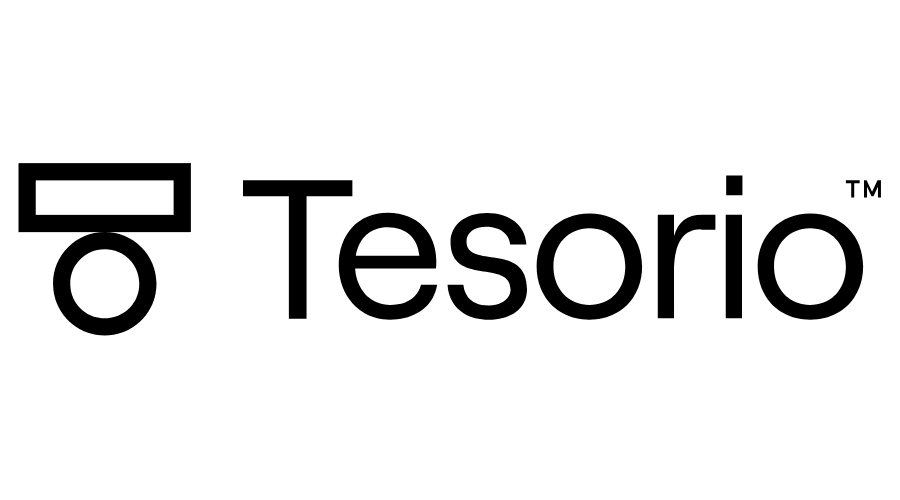
Tesorio is an "A/R Cash Flow Performance Platform" designed to replace cash flow forecasting and collections processes. Its key value is allowing teams to collect cash faster. Tesorio synchronizes with ERP systems so that nothing slips through the cracks.
Tesorio isn't a complete FP&A platform and gets your cash flow management out of spreadsheets, so that's a consideration for scaling teams.

Key features
- Cash aggregation to consolidate cash flow data from various sources
- Search analysis so you can quickly navigate and analyze financial data
- Unified account reporting that combines accounting data into one handy dashboard
- Risk assessment that evaluates and manages unforeseen circumstances
- Dunning management to automate customer overdue payment reminders
Integrations
Tesorio has an impressive integration list, with Google Sheets handling data manipulation, Intuit QuickBooks for comprehensive accounting capabilities, and Stripe, Sage Intacct, Xero, and NetSuite ensuring robust financial data integration.
Snowflake provides advanced data analytics, while Workday and Blackbaud are for HR and non-profit financial management. It links to Acumatica and PLEX for manufacturing and business management solutions while security and identity management are enhanced with Okta, OneLogin, and Azure integrations.
Pros
- Helps teams reduce days sales outstanding
- Integrates effectively with many ERP systems
Cons
- Struggles with performance on large data sets
- Functions as a specialized tool that lacks broader FP&A support
Customer review ratings: Gartner: 4.2/5
Pricing
Tesorio requires a demo for pricing.
Cube vs. Tesorio
Tesorio and Cube are fundamentally different use cases. Tesorio is more of an accounting system, so it lacks a lot of the planning power that Cube offers. If you’re looking for cash forecasting or using insights to plan or budget, Cube is by far the better option.
10. Prophix

Prophix is a cloud-based financial performance platform that helps companies budget, consolidate data, plan, and report. Like many other tools on this list, Prophix is designed to rip and replace the spreadsheet with new software.

Key features
- Financial consolidation that combines data from multiple sources into one place
- Close management to stay on top of payments
- Automations and workflows across the board to streamline repetitive processes
- AI insights that pick up on opportunities and risks you may not notice yourself
- Microsoft 365 add-ins give you a broader spectrum of functionalities
- Intercompany management so you can isolate specific areas or visualize the business as a whole
Integrations
Prophix integrates with the Microsoft suite like many other products on this list. When it comes to ERP systems, it features a detailed list of options such as Acumatica, Deltek, Ellucian, QAD, Sage Intacct, SYSPRO, TOTVS, and Viewpoint.
Pros
- Provides robust consolidation features for easy organizational changes
- Delivers powerful ad hoc reporting capabilities
Cons
- Extends implementation timelines beyond expectations
- Requires purchase of extra support hours due to consultative support model
Customer review ratings: G2: 4.4/5
Pricing
Requires a demo.
Compared to Prophix, Cube is a far more user-friendly solution that can be quickly and confidently integrated. While the usability isn’t bad, Prophix’s inability to keep existing reports and templates is rather disappointing.

11. HighRadius

HighRadius is a fintech enterprise SaaS company that sells AI-based technology to help companies automate their cash management processes. They offer solutions for autonomous receivables and autonomous treasury, optimizing processes across order-to-cash, treasury, and record-to-report cycles.

Key features
- Automated collections and treasury payments
- Cash application management to add efficiencies to your workflows
- Credit management to assess and manage customer credit risk
- Payment gateway for SAP to streamline payment processing
- Anomaly management that lets you identify and manage financial anomalies
Integrations
HighRadius integrates with popular ERP systems like Microsoft Dynamics 365 Business Central, SAP, NetSuite, and Sage Intacct. It also supports HR and financial platforms like Workday and Stripe for streamlined payment processing. In terms of banking institutions, HighRadius connects with major banking institutions such as JPMorgan Chase & Co, Bank of America, BBVA, and Wells Fargo. Additionally, it integrates with Salesforce for CRM, Prophix for financial planning, and logistics providers like UPS, FedEx, Target, and Walmart.
Pros
- Automated bank reconciliations acriss accounts
- Provides continuous global cash visibility
- Maintain rolling short-term cash positions
Cons
- Runs slowly for some users, creating unnecessary delays
- Provides limited accessto support and documentation
- Presents a sleep learning curve that complicates setup and onboarding
Customer review ratings: G2: 4.3/5
Pricing
HighRadius directs you to a consultant who assesses your level of customization before making a quote.
Cube vs HighRadius
Cube enhances financial planning and analysis by extending spreadsheet functionalities. HighRadius specializes in automating the accounts receivable and treasury functions, focusing on streamlining cash applications, credit management, and collections.
While Cube is tailored for financial analysis and planning, HighRadius is more for automating the order-to-cash cycle for businesses.
12. Jirav
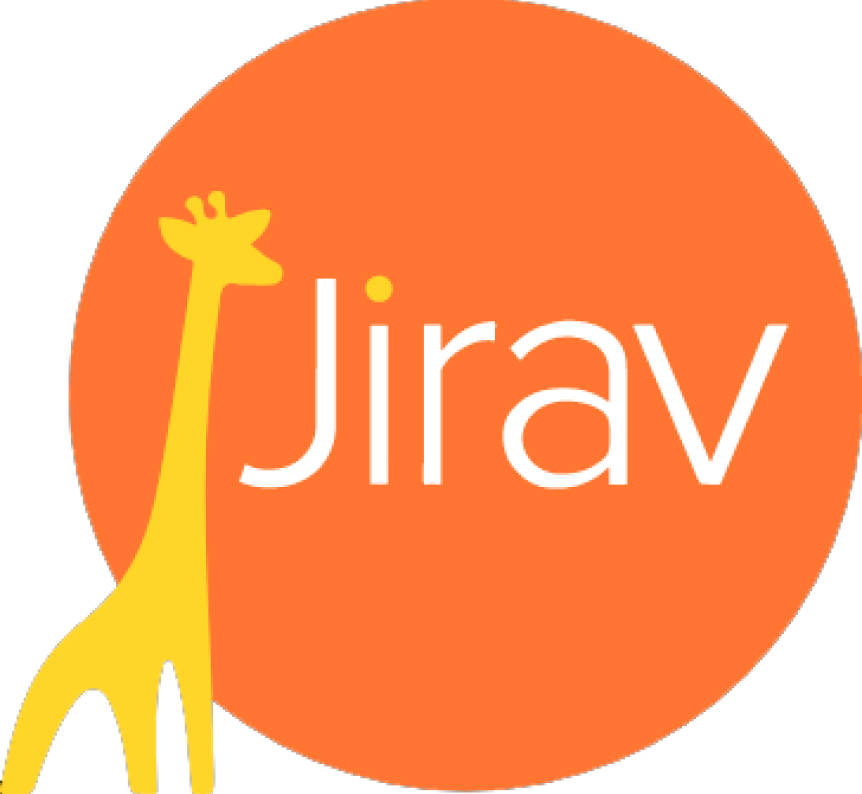
Jirav is a driver-based planning tool that replaces your Excel model. Jirav has cash flow analysis and forecasting capabilities, so it's an option for teams who want a different approach to their cash management.
Jirav is best for small-to-medium-sized businesses that aren't reliant on their Excel models.
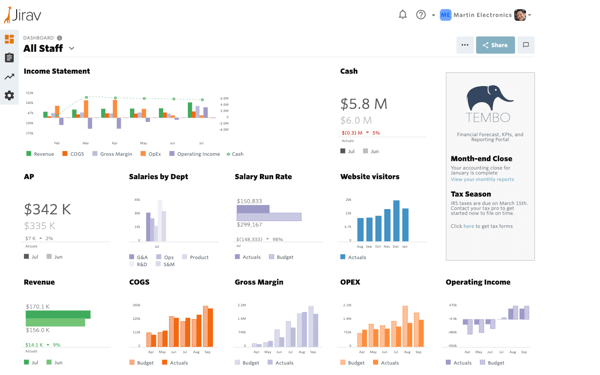
Key features
- Industry-specific KPIs to get the most relevant metrics for your company
- Board-ready reporting templates for quicker and clearer cash flow presentations
- Departmental reporting to pinpoint the financial health of specific teams
- Budget vs actual analysis to accurately analyze your performance
- Annual operating plan to develop and manage yearly projections
- Rolling forecasts to give you the most up-to-date information at all times
Integrations
Jirav offers a huge range of integrations covering accounting software like Intuit QuickBooks, Xero, NetSuite, and Sage Intacct, as well as data processing classics such as Microsoft Excel and Google Sheets. For payroll and HR management, Jirav integrates with ADP, Gusto, Paychex, Justworks, BambooHR, Paylocity, TriNet, and UKG, while CRM integrations include Salesforce, HubSpot, and PipeDrive.
Additionally, Jirav connects with data-handling apps like Google Analytics, Tableau, Snowflake, Google BigQuery, Amazon Redshift, Microsoft SQL Server, MySQL, and PostgreSQL. Stripe and Shopify help e-commerce users, while Jira and Zendesk help you organize cash flow management projects.
Pros
- Shares dashboards easily with team members
- Tracks budgets in real time
- Provides granular visibility into financial data
- Creates custom tables for detailed reporting
Cons
- Runs slowly at times
- Provides limited integration options
Customer review ratings: G2: 4.7/5
Pricing
- Controller essentials: $50/month
- CFO enterprise: $150/month
It's easy to dynamically compare scenarios in Cube, whereas Jirav can feel more limiting. As a bonus, Cube has unlimited scenarios, but with Jirav you'll need to pay extra. Some of Jirav’s integrations are somewhat complicated. This contributes to higher implementation costs and longer timelines; you'll need to rebuild your back-end logic in Jirav.
13. SAP Cash Management

SAP Cash Management is part of the larger SAP ecosystem. It's a powerful cash management platform, but teams not already using SAP might find that the cost outweighs the benefits.

Key features
- Bank relationship management to maintain transparency with financial entities
- Cash flow forecasting for planning and presentations
- AI simulations and projections for quicker, more accurate predictions
- Historical comparison and analysis for accurate insights into risks and performance
- Cloud deployment for scalability and flexibility, especially with remote teams
- Real-time visibility of global cash positions
Integrations
Integrations include SAP S/4HANA Cloud, SAP SuccessFactors Employee Central Payroll, and SAP ERP HCM Payroll. SAP Master Data helps you maintain accurate and consistent financial data across the organization, while SAP Concur is great for efficient travel and expense management. That said, the lack of third-party integrations is highly restrictive for most cash flow managers.
Pros
- Integrates seamlessly for organizations already using SAP ERP
- Delivers real time access to accurate cash information
Cons
- Requires high costs and extensive workarounds outside of SAP ERP
- Demands a steep learning curve for those unfamiliar with SAP
Customer review ratings: G2: 4.2/5
Pricing
SAP requires you to request a demo before discussing pricing structures.
Cube vs SAP Cash Management
Companies that go for Cube often have their own systems up and running and are happy with them. Cube unites them all into one central space without diminishing the advantages of each app.
On the other hand, SAP Cash Management implicitly nudges decision-makers to migrate all of their operations to the SAP ecosystem. As one of the industry leaders, SAP software has a strong reputation, but unless you’re already using SAP, the costs and learning curve are pretty off-putting.
14. Kolleno

Kolleno is a "smart credit control platform" and automated accounts receivable solution for businesses looking to streamline their financial operations. It helps finance teams with payment processing, improved credit control, and accuracy in their accounts.

Key features
- Accounts receivable management
- In-built to-do lists to manage tasks and projects, leaving nothing to fall through the cracks
- Automated task and workflow creation that saves time and streamlines workflows
- AI cash application that learns from your past actions and applies them to current projects
- Real-time interactive dashboards give you a continuous view of your financial health
Integrations
Kolleno streamlines your accounts receivable and cash flow management processes through integrations with payment processing systems like Stripe and GoCardless. It also connects with major accounting software such as NetSuite, Intuit QuickBooks, Microsoft Dynamics 365 Business Central, Xero, and Sage Intacct.
Pros
- Automates many manual tasks like collections and forecasting
- Provides ready made reports that simplify financial tracking
Cons
- Delivers reports can be too simple for advanced needs
- Presents a sleep learning curve with limited documentation
Customer review ratings: G2: 4.9/5
Pricing
Kolleno has three pricing tiers aimed at small firms, mid-market firms, and enterprises, but doesn't list any prices on its website. You'll need to book a 15-minute demo before trying out their software and agreeing on a subscription model.
Cube vs Kolleno
Cube and Kolleno are essentially designed for different aspects of financial management. Cube’s focus is largely on financial planning and analysis, whereas Kolleno focuses on automating and optimizing accounts receivable processes. Even so, you get a lot more bang for your buck with Cube, which offers a much broader solution for cash flow management.
15. PlanGuru

PlanGuru is a planning tool for budgeting, forecasting, and performance reviews for small and mid-sized companies. It integrates with Quickbooks and Excel, making it easy to use and use for cash management.

Key features
- Budgeting and forecasting to create detailed models
- Automatically solved cash flow statement to reduce time-consuming admin
- In-built financial statement structure to optimize financial reporting
- Quick-glance financial ratios to monitor progress quickly
- Web-based dashboards that display KPIs to you and your clients
Integrations
PlanGuru doesn’t advertise a great deal of integrations. However, it does cover some of the most common, including Microsoft Excel, Xero, and Intuit QuickBooks
Pros
- Incorporates customer feedback into continuous improvements
- Enables quick and easy scenario planning
Cons
- Makes sharing reports difficult
- Lacks integrations with payroll and other systems
Customer review ratings: Capterra: 4.2/5
Pricing
PlanGuru offers two pricing tiers:
- Single Entity: $83/month
- Multi-Department Consolidations: $250/month
Cube vs PlanGuru
PlanGuru caters to a slightly different audience within financial management. It focuses mainly on budgeting and forecasting, and while you can create comprehensive financial models and multi-year projections, there isn’t much PlanGuru does that Cube can’t take care of.
With a more user-friendly approach, Cube enhances workflows right across the board.
16. Float
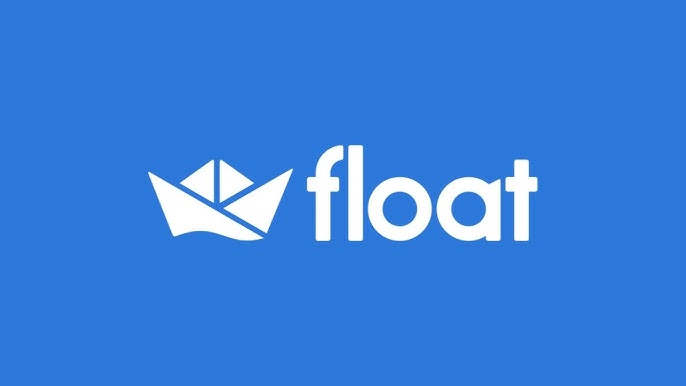
Float is designed primarily for cash flow forecasting and scenario planning. It integrates with Xero, QuickBooks Online, and FreeAgent accounting software, with real-time data syncing. Float uses this data to display a company’s financial future on detailed forecasts and models so they can make more informed decisions regarding their cash flow.
Float is great for teams that deal with complex project-based financial planning, offering tools to assess outcomes based on varying scenarios.
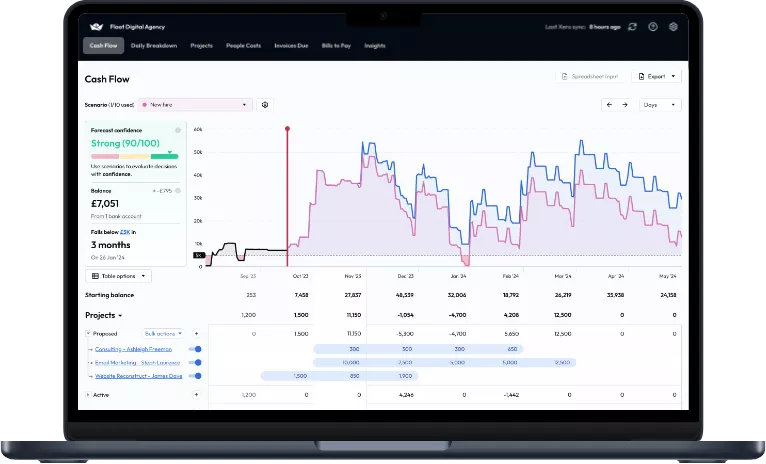
Key features
- Instant forecasts with real-time data syncing
- Sales pipelining to monitor cash flow at specific stages
- Hiring management to keep control of onboarding and payroll costs
- Project performance tracking at a granular level
- Comparative scenario planning to assess different options
Integrations
Float connects you to a range of accounting, calendar, productivity, and project management tools. Chief among them are the Microsoft and Google suites, but you can also find Intuit QuickBooks, FreeAgent, Xero, Slack, Trello, Asana, and Jira to streamline your cash flow forecasting and management.
Pros
- Delivers visual forecasting that make scenario planning intuitive
- Provides a clean and straightforward interface that makes it easy even for non-experts
Cons
- Limited reporting capabilities don’t offer the depth that many larger businesses need
- Laser-focused functionality on cash flow and few integrations neglects areas like expense tracking and revenue analysis
Customer review ratings: G2: 4.4/5
Pricing
Float offers three transparent pricing tiers, each aimed at different business sizes.
- Essential: The low-cost option for three users. $59/month
- Premium: More features for 10 users. $99/month
- Enterprise: Complex cash flow management for 100 users. $199/month
Cube vs Float
Cube and Float both specialize in cash flow forecasting and real-time financial analysis. However, Float encourages users to forget spreadsheets. While this is a good option for some, it puts an unnecessary limitation on its own product, making it unsuitable for many FP&A teams.
17. Agicap

Agicap is a treasury management platform that helps businesses monitor cash flow, optimize payments, and improve forecasting. The software centralizes accounts payable and receivable, connects directly with banks and ERP systems, and provides real time visibility into cash positions. With more than 8,000 finance teams using Agicap, the platform focuses on helping organizations make faster and more reliable financial decisions.
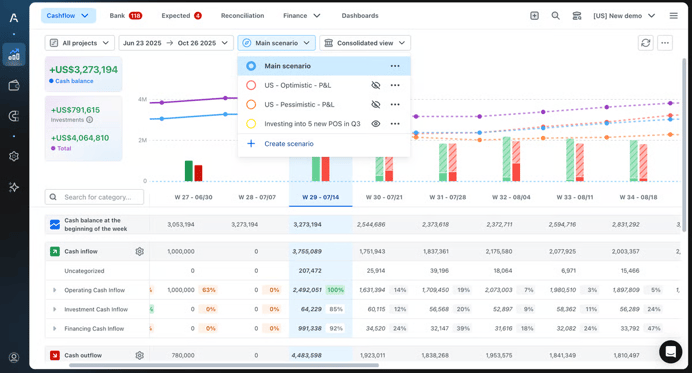
Key features
- Provides treasury management tools that deliver real-time cash visibility and future forecasts
- Connects banks and ERP systems to create a single source of truth across financial data
- Automates reconciliation with AI powered matching of bank transactions and invoices
- Creates customizable dashboards and reports for analysis and collaboration
Integrations
Agicap connects directly with global banking systems and ERP platforms to unify data and streamline treasury workflows. The platform supports real time synchronization of customer and supplier data, simplifies reconciliation, and redistributes information across accounting and business tools. Agicap integrates with Xero, QuickBooks, and Sage for accounting, NetSuite and Microsoft Dynamics for ERP, and connects with more than 400 banks worldwide. It also supports two way data sync through API and SFTP, giving finance teams flexibility to continue using their existing systems.
Pros
- Provides complete visibility into daily liquidity and cash forecasts
- Automates payable and receivable workflows to save time
- Connects seamlessly with banks and ERP systems for reliable data
- Delivers intuitive dashboards that simplify reporting and collaboration
Cons
- Limits functionality for highly complex corporate structures
- Presents a learning curve for finance teams new to treasury management platforms
Customer review ratings: G2: 4.4/5
Pricing: Offers personalized demos and pricing.
Cube vs Agicap
Cube focuses on enhancing existing spreadsheet models by integrating directly with Excel and Google Sheets. Finance teams keep their familiar workflows while adding automation, real time reporting, and scenario planning without heavy onboarding.
Agicap positions itself as a full treasury management system that centralizes payable, receivable, and bank connectivity.
For teams that already rely on Excel or Google Sheets, Cube provides faster adoption and easier customization. Agicap works best for companies that need advanced treasury and banking connectivity but are willing to move away from spreadsheet based models.

Choose the right cash flow management software for your business
Cash flow management doesn’t need to be a challenge or a chore. Referencing this list is a great place to start to enhance your existing financial tools with sophisticated analytical and forecasting features.
Want to learn why our customers trust Cube for cash flow management? Book a free demo today to see the benefits for yourself.
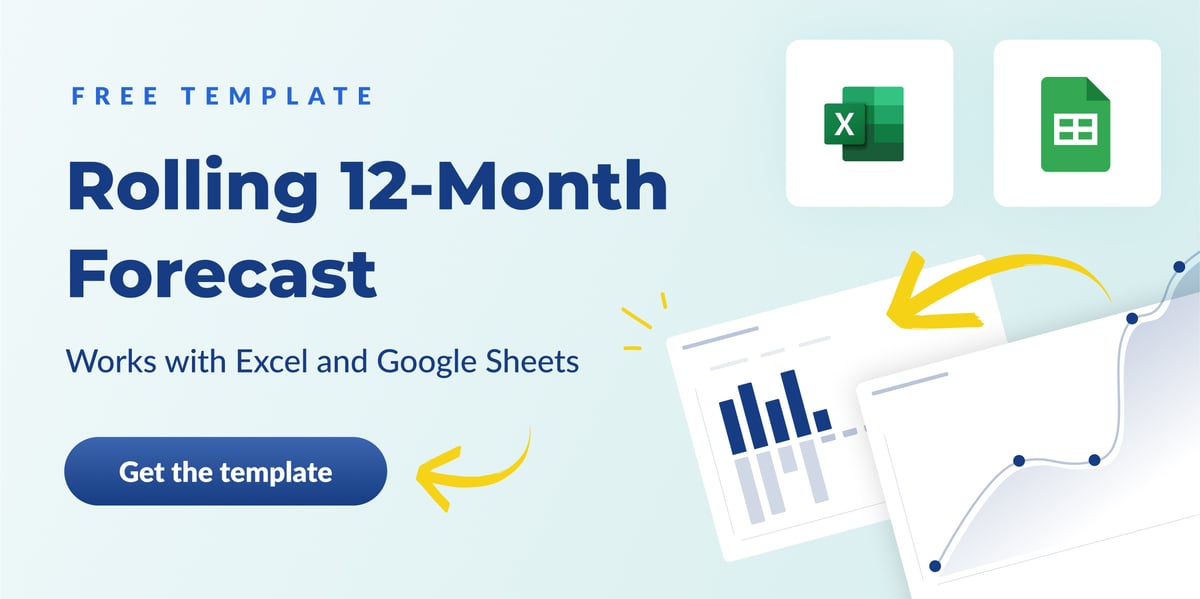


.png)









.png)
.png)
![16 best cash flow management software tools [2026]](https://www.cubesoftware.com/hubfs/Cash-Flow%20(1).webp)







.png)
.png)
%20(1).png)